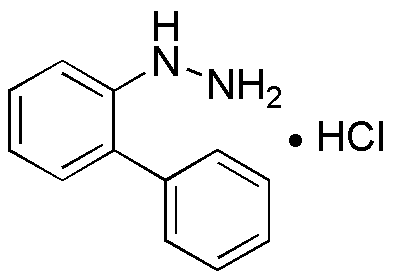Biphenyl-2-yl-hydrazine hydrochloride is widely utilized in research focused on:
- Pharmaceutical Development: This compound serves as an essential intermediate in synthesizing various pharmaceutical agents, particularly those targeting cancer and other serious diseases.
- Analytical Chemistry: It is used as a reagent in analytical methods to detect and quantify specific compounds, enhancing the accuracy of chemical analysis in laboratories.
- Material Science: The compound plays a role in developing advanced materials, including polymers and coatings, which require specific thermal and mechanical properties.
- Agricultural Chemistry: It is applied in creating agrochemicals, contributing to the development of effective pesticides and herbicides that help improve crop yields.
- Biochemical Research: Researchers utilize it in studies of enzyme activity and protein interactions, aiding in the understanding of biological processes and disease mechanisms.
General Information
Properties
Safety and Regulations
Applications
Biphenyl-2-yl-hydrazine hydrochloride is widely utilized in research focused on:
- Pharmaceutical Development: This compound serves as an essential intermediate in synthesizing various pharmaceutical agents, particularly those targeting cancer and other serious diseases.
- Analytical Chemistry: It is used as a reagent in analytical methods to detect and quantify specific compounds, enhancing the accuracy of chemical analysis in laboratories.
- Material Science: The compound plays a role in developing advanced materials, including polymers and coatings, which require specific thermal and mechanical properties.
- Agricultural Chemistry: It is applied in creating agrochemicals, contributing to the development of effective pesticides and herbicides that help improve crop yields.
- Biochemical Research: Researchers utilize it in studies of enzyme activity and protein interactions, aiding in the understanding of biological processes and disease mechanisms.
Documents
Safety Data Sheets (SDS)
The SDS provides comprehensive safety information on handling, storage, and disposal of the product.
Product Specification (PS)
The PS provides a comprehensive breakdown of the product’s properties, including chemical composition, physical state, purity, and storage requirements. It also details acceptable quality ranges and the product's intended applications.
Certificates of Analysis (COA)
Search for Certificates of Analysis (COA) by entering the products Lot Number. Lot and Batch Numbers can be found on a product’s label following the words ‘Lot’ or ‘Batch’.
*Catalog Number
*Lot Number
Certificates Of Origin (COO)
This COO confirms the country where the product was manufactured, and also details the materials and components used in it and whether it is derived from natural, synthetic, or other specific sources. This certificate may be required for customs, trade, and regulatory compliance.
*Catalog Number
*Lot Number
Safety Data Sheets (SDS)
The SDS provides comprehensive safety information on handling, storage, and disposal of the product.
DownloadProduct Specification (PS)
The PS provides a comprehensive breakdown of the product’s properties, including chemical composition, physical state, purity, and storage requirements. It also details acceptable quality ranges and the product's intended applications.
DownloadCertificates of Analysis (COA)
Search for Certificates of Analysis (COA) by entering the products Lot Number. Lot and Batch Numbers can be found on a product’s label following the words ‘Lot’ or ‘Batch’.
*Catalog Number
*Lot Number
Certificates Of Origin (COO)
This COO confirms the country where the product was manufactured, and also details the materials and components used in it and whether it is derived from natural, synthetic, or other specific sources. This certificate may be required for customs, trade, and regulatory compliance.


